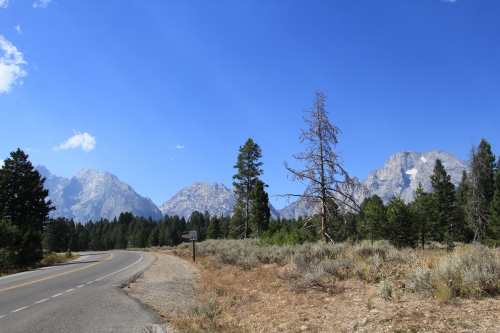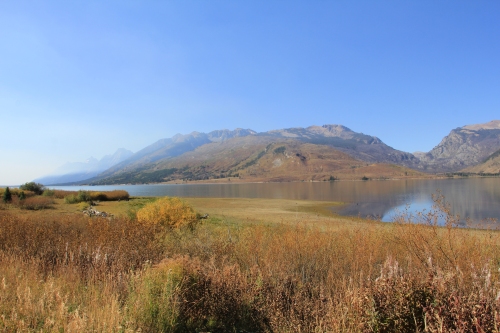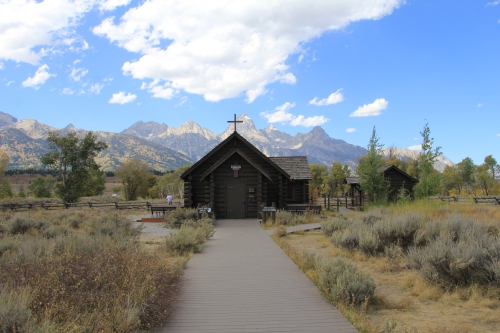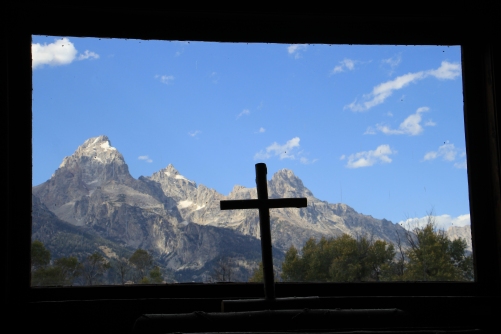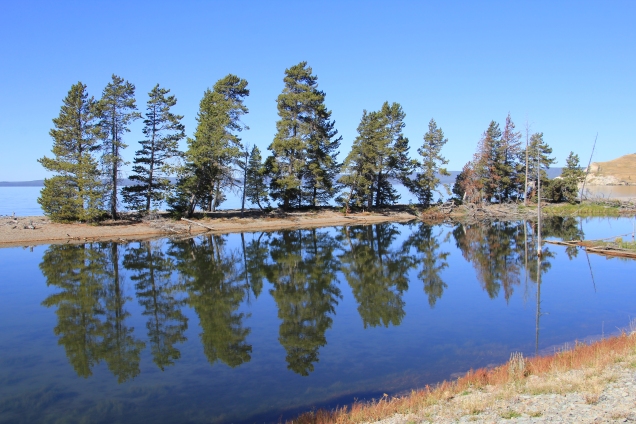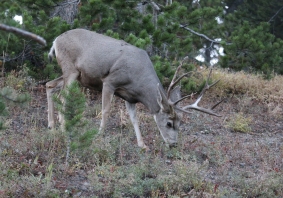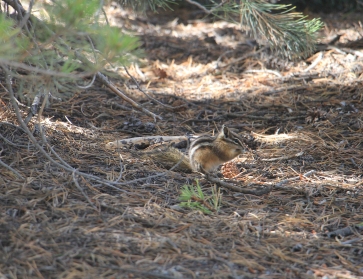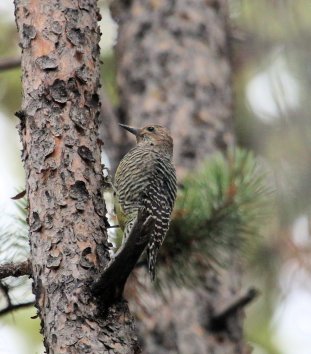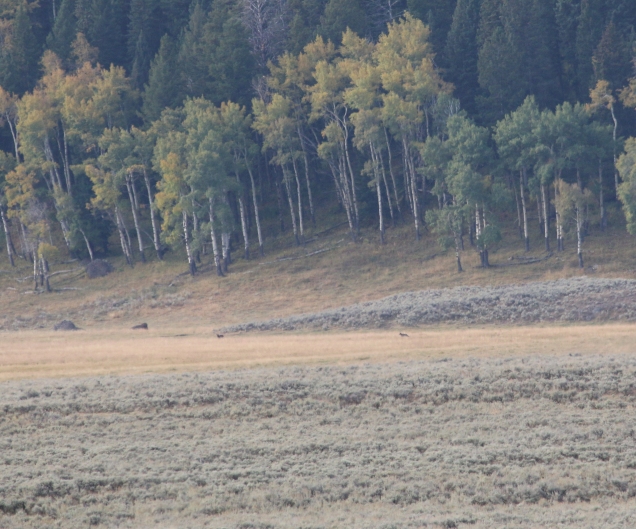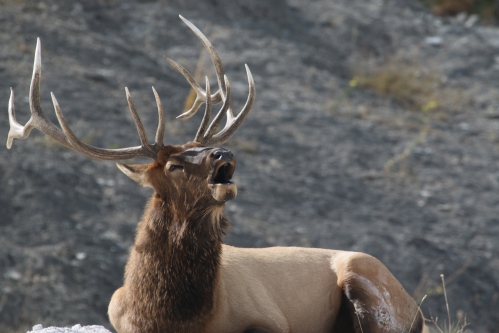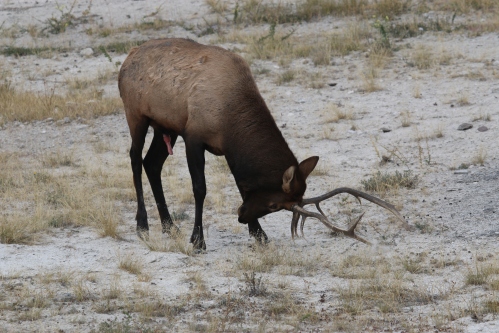19 September 2018, Touring Grand Tetons National Park (Wyoming) : 91 miles
It’s been a strange sort of day, a little bit of this, a little bit of that, with no dominant theme or special highlight. It was a lot of fun, though. So settle back, dear reader, make yourself a nice cup of tea (or a pour yourself a G&T if that’s what floats your boat) and let the Platypus Man tell you all about it.
A distant view of critters
Setting off from Jackson, we’ve driven just a few miles before we see a coyote loping through the meadow. He’s clearly on a mission, and obviously has ambitions to be a wolf. He’s giving it some, swaggering confidently through the long grass, sun gleaming off his sleek greyish-yellow coat. Sadly we can’t stop on the highway, and bid him a sad farewell as we head off into the Grand Tetons National Park.
Within a few miles we come across a commotion. Traffic is at a standstill, cars are parked all over the place, the air is fizzing with excitement. A park ranger is strutting around, making clear who’s in charge of this show. In the distance Mrs P spots a Black bear cub crossing the road. She and several other people move to get out of their cars, cameras at the ready.
“Get back in your cars,” the ranger bellows, self importance oozing from every pore. If he knows that most of the people he’s shouting at have waited years, maybe even their whole lives, to see a bear cub up close, he’s not letting it spoil his opportunity for a good bellow. Everyone gets back in their cars. Meanwhile the bear cub has scarpered, and pretty soon after we move on too, lamenting a lost opportunity.

We arrive back at the spot where, yesterday evening, the bull (male) moose with the enormous rack of antlers was dozing in the undergrowth. He’s moved on, but instead a cow moose and her calf are lying in the shadow of a tall pine tree. They’re a couple of hundred yards away and largely hidden by vegetation so we can’t see much of them, and apart from flicking their ears every now and then to keep the flies away they’re not moving. We wait for over an hour in the hope of some action, but in the end give up in despair. Moose can be contrary, miserable buggers and these two – not to mention yesterday’s male – are a case in point.
In the middle of nowhere
We drive on to Antelope Flats. Sadly the antelope are nowhere to be seen, but this area of the Park is famous for a series of historic homestead buildings, including barns, other outbuildings, corals and fences all dating from the 1890s. This is Mormon Row, and the setting is idyllic, lying in the open sage flats and overlooked by the soaring peaks of the Tetons. Unfortunately, the view of the mountains is once again spoiled by smoke from the wildfire, but we can see enough of them to appreciate the magnificence of the location.

Welcome back, old friend
As we move on from Mormon Row we are surprised and delighted to spot, in the far distance, bison grazing on the flats. We haven’t seen them on previous visits to the Grand Tetons and didn’t even know they were here, but in fact there are said to be several hundred roaming freely in the National Park. They are not nearly as plentiful, nor as confiding, as their iconic cousins in Yellowstone but it’s great to know they’re around if you look carefully.
Did you feel the earth move?
We head out of the National Park and into the Bridger-Teton National Forest, along the Gros Ventre River. Here, in 1925, occurred one of the largest-ever recorded landslides. Some 38 million cubic metres of rock slid 9,000ft down the north face of Sheep Mountain, crossed over the Gros Ventre River and rode up the opposite mountainside a distance of 91 metres.

The landslide created a dam wall over 60 metres high and 300 metres wide across the river, backing up the water and forming Lower Slide Lake. Two years later part of the landslide dam failed, resulting in a massive flood downstream that wiped out the small town of Kelly and killed six people. Although Lower Slide Lake remains, it is much smaller now than at its height.
To the untrained eye there’s little hint of the dramatic events that happened here nearly a century ago. The valley is peaceful, and the autumn foliage is as spectacular here as elsewhere in the Tetons.

Arts and Crafts
Our next stop is the National Museum of Wildlife Art, on the outskirts of Jackson. It’s a superb museum, and worthy of a post all of its own which follows on after this one. However, there is a Sculpture Trail outside the building, and one of the pieces has special relevance to our experiences over the past 24 hours. As I’ve already mentioned, moose are contrary buggers that like to keep their heads down, so this sculpture from the Trail is probably the best sighting of a male moose we’ll see all holiday.

Bearing up
After enjoying the moose sculpture we decide to have one last try for the real thing at our favourite spot, but no luck.
However, lots of other people are intently watching a stand of trees a hundred metres or so across the road. We’re told there’s a Black bear there, and watching through binoculars we can see a bit of movement, but nothing that makes us feel it was worth the effort of coming back here. Disconsolately we drive back towards Jackson, and after a mile or so comes across more traffic chaos. There’s another Black bear up a tree close to the road, clearly visible this time, snacking on fruit of some sort. We can’t park due to the chaos, but Mrs P snaps a shot through the car window as we drive slowly past. At last, a decent, close-up view of a Black bear, if only for just a few seconds.

Gotcha!
Feeling much more chipper, we continue the drive towards Jackson, watching out for the site of yesterday’s humiliation. Twenty-four hours ago, driving the same stretch of road, Mrs P suddenly shouted out “moose, moose”. I screeched to a halt, sending a up plume of burning rubber and causing alarm amongst motorists behind me. However the ‘moose’ was actually a black metal silhouette, placed at the roadside with the sole – and unspeakably cruel – intention of catching out people just like us.

I will confess that many years ago in Minnesota Mrs P and I were fooled by a model owl strategically placed on a telegraph pole, and spent 20 minutes trying to get the perfect photo before realising that the ‘owl’ was far too motionless for a living bird. Oh, the humiliation.
I never thought we’d get caught out like that again, but yesterday proved me wrong. This evening, for a laugh, Julie takes a photo as we drive past and it’s pleasing to see, just in front of us, a pick-up truck slam on the brakes as the driver falls for it too. Silly bugger!
